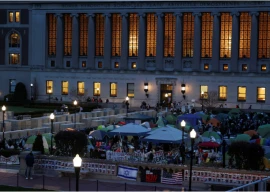
After the Bengal Army’s mutiny of 1857, the subcontinent came directly under the crown and a new — third, according to Hamza Alavi — phase of the colonial administration began. While the previous phase was characterised by a transfer of wealth in terms of cash — used to build the textile and other industries of Britain — it was decided in the latter half of the nineteenth century by the colonial rulers to turn the subcontinent into a supplier of raw material for the British industry, grain for its populace and soldiers for its colonial army.
These decisions were to have a deep and lasting impact on the individual and collective lives of the inhabitants of this region. A huge canal network was constructed in the northern plains of Punjab and UP to make the land capable of growing cotton, sugarcane, wheat and other important crops. New mandi-towns and port cities were developed and railways and road networks were built to transport agricultural produce and industrial products, and to move troops. These public works brought into being an institution called the thekedar, or contractor, which ensured the supply of labour and materials of all kinds for a commission. Modern civic and administrative services of water supply, sewerage, transport, law courts, policing etc. were developed in urban centres. Important changes were made in the recruitment policy of the British Indian Army and a ‘theory’ of the so-called ‘martial races’ was invented to support it.
All these changes were taking place side-by-side with developments in technology that changed the way people communicated with each other. While modern post and telegraph transformed communication between individuals and families, the currency of the printing technology changed the way knowledge was disseminated and shared. Since all these developments needed new skills and forms of knowledge at every level, a large system of public education was put in place, the like of which had never existed in previous eras. People from some of the lower castes who were considered unfit to get education under the traditional system of hereditary occupations, were now allowed to acquire skills needed for the modern systems and to change the way they earned their livelihood.
Among the mainstream Muslim communities of North India, there were two significant elite reactions to this. The MAO College at Aligarh (later to be called Aligarh Muslim University) and the religious madrassa at Deoband (later to be known as Darul Uloom of Deoband) could be taken as expressions of these two reactions. There has been a tendency among social analysts and critics of making much of the differences in the approach of Aligarh and Deoband. However, their commonalities could be much more significant and revealing from another perspective. While the two elite points of view had some differences with respect to the rationality of the biases against non-Muslims and against minority Muslim sects, they displayed an identical repugnance towards people of low birth whose aspirations to acquire education, change their profession and improve their lives turns them into ‘upstarts’. Both these ‘educational’ movements and their leaders were clear about the class they were meant to serve and benefit. It was the well-defined class of Muslims who considered themselves of high birth and called themselves shurafa. While the phenomenon called Aligarh, with its impact on the politics of Muslim identity in the subcontinent, deserves to be studied from this angle separately, just now I would like to focus on Deoband which produced the quintessential character I have chosen to call ‘the modern maulvi’.
Masood Alam Falahi, a young graduate of a madrassa in Bihar who went on to do his M Phil and PhD in Delhi, has written a book called Hindustan Mein Zaat-Paat Aur Muslman in 2007 (reissued in a revised and enlarged form in 2009 and available in English translation on the internet at newageislam.com). This book is a treasure trove of revealing quotations from the Muslim religious and historical literature of the subcontinent on the subject. Among other things, Falahi quotes an interesting anecdote about Aligarh written by the famous Deobandi Maulana Ashraf Ali Thanvi (1863–1943) in his collection of responses to religious queries called Ashraful Jawab, which shows how the firm policy of segregating and differentiating between people of higher and lower castes was a common factor between Aligarh and Deoband. The learned maulana apparently respected the deep, though misplaced, concern of the questioner about the dangers of mixing people of higher and lower origins at places like Aligarh. In his response, Thanvi writes: “An Englishman went to visit Aligarh College. He saw that while the sons of aristocrats (raeeson ke larke) studied, the servants accompanying them stood and waited at a distance; they could not even think of sitting next to their masters. But at the time of the namaz, the servants and masters stood next to each other. He asked the raees-zadas if standing shoulder to shoulder during the prayers did not make these servants bold and impudent. He was told that they could not dare to consider themselves equal in any way to their masters after the namaz.”
He then goes on to state: “The haq during namaz is that everybody should be equal, and the hukm for other times is different.”
In the remaining parts of the current series, I am going to comment on the life and thoughts of Maulana Ashraf Ali Thanvi who, in my view, perfectly fits the bill of the modern maulvi.
Published in The Express Tribune, September 10th, 2011.
COMMENTS (9)
Comments are moderated and generally will be posted if they are on-topic and not abusive.
For more information, please see our Comments FAQ


































1713853507-0/MalalaHilary-(2)1713853507-0-270x192.webp)








@shahid: Most of the sufis in india were sayyids and they never transferred khilifah to their low caste puplis. If you can give some proofs against my claim I will be very happy. Infact sufis maintained the superiority of hight castes.
Abu Shariq Aligarh India
کانو دے بچے ہنس نہ تھیندے موتی چوگ چگایئے ہُو کھوہ نہ مٹھے ہوندے باہو سئے مناں کھنڈ پایئے ہُو
Well the concepts of cast and superiority have been a part of the sub-continent's culture for thousands of years and every one has indulged in it. The above verse is from a SUFI named Bulleh Shah.
Islam in fact Islam did lower these differentiations - and every one participated in this effort, sufi or non-sufi.in fact his distinction is rather silly as vast majority of those who spread Islam were sufi's and also abided by the teachings of the Islamic shariah.
once some body asked Gandhi ji what kind of sys you wanna see in india he replied umer (second khalife of early muslim) had rulled the world no one can do like that i wish we had that kind of sys. early islam shaw us how we can live.
@Abu Shariq:
Castiesm exists in Islamic Countries too, although a different name is given to it. The Shias and Sunni conflict in places like Iraq and Pakistan are a classic examples.
Man divides man. Doesn't matter whether it is in India or Pakistan or Iraq.
This article helps us to understand that how the vision of Islam, in which every human being is equal, was tampled in the casteist enviornment of India.
Bias against women is common to most religions, though there are exceptions. Sects worshipping women as supreme place women as superior to men. The Shakta group in India with its tantric worship patten is one modern surviving example. The Goddess Kali is depicted in Shakta scriptures as wiping out thousands of evil men in her way. Further, the iconic description of her husband (the Hindu God Shiva) at her feet and she placing her foot on him symbolize the superiority of women over men.
It is unfair to call the 1857 mutiny a Bengali army mutiny. Its spread was throughout north india.It is hard to think of the Aligarh University and what it stands for in the same line with Deoband school. But yes, the underlying approach seems to be the same. Aligarh did create many leftists as well but like the Hindu lefists and communists they too maybe largely from the upper castes among muslims
Many thanks for providing reference to mr. Masood Alam Falahi's book on internet, I tried hard but failed to buy a copy of the book, even I requested many persons visiting India to buy for me but in vain. Advertised contents of the book are interesting, however now I found opportunity to see on website.